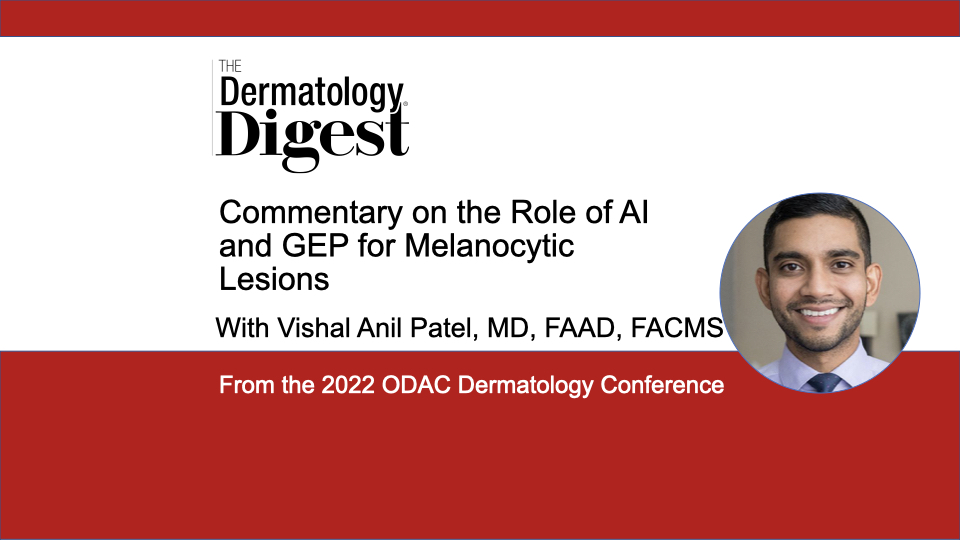Dr. Vishal Patel discusses the current role and future potential of artificial intelligence and gene expression profiling in the dermatology specialty.
LISTEN to Dr. Patel discuss in more detail the opportunities, challenges, and potential for artificial intelligence in dermatology.
Vishal Anil Patel, MD, FAAD, FACMS, Director of Cutaneous Oncology, GW Cancer Center, Director of Dermatologic Surgery, GW Department of Dermatology, and Assistant Professor of Dermatology & Hematology/Oncology, George Washington University School of Medicine & Health Sciences, Washington, D.C.
“The role of AI and gene expression profiling for melanocytic lesions is understanding that our clinical ability to accurately identify melanomas is not as great as we think it generally is,” said Vishal Anil Patel, MD, FAAD, FACMS, who presented “Role of AI and Gene Expression Profiling for Melanocytic Lesions” at the 2022 ODAC Dermatology Conference.
“We tend to biopsy a lot of lesions to find very few consequential melanomas. [We can] improve our diagnostic accuracy if we have tools to help us do so.”
While the prospect of artificial intelligence (AI) earlier on was met by many with skepticism and resistance, today it is better understood to be a supplementary tool rather than a human replacement, said Dr. Patel.
“AI is a diagnostic support tool when calibrated correctly. It’s very powerful in the hands of a good operator, which is the physician. It always falls back to the dermatologist to make that clinical decision. …you have more tools to accurately personalize that decision for the patient.”
AI offers promise for improving diagnostic accuracy, but we’re not quite there yet, said Dr. Patel.
“It’s a little bit of a wild, wild west. Are all AI tools equally effective? Do different technologies work better than others? Different companies? Different products? We haven’t even begun to answer [those questions].”
Although gene expression profiling (GEP) is a type of AI, said Dr. Patel, it’s a little different. AI is generally thought of as a supportive resource for imaging and diagnostic tools. GEP tests to determine if a lesion is melanoma and if it is likely to recur or metastasize.
“It essentially uses a mathematical model based on gene expression to take the input—an identified melanoma—to determine if that melanoma will be aggressive or more benign. And that has become much more readily available in the recent years, as we have more robust databases.”
Still, dermatologists should use GEP technology with care, said Dr. Patel.
“While that’s really promising and really exciting for melanoma specifically, I urge caution. We need to be really discerning in our use of that because we don’t have long term data or prospective trials to know how to use GEP to determine treatment or surveillance and how the test results impact morbidity or mortality, specifically.”
According to Dr. Patel, the existing model for GEP is based on older data sets.
“We’re really pushing for prospective clinical trials where patients get standard care therapy but also have a [GEP] test.”
Based on that test result, researchers would then randomize patients into groups “so we can compare if that really makes a difference—not looking at patients in the past.”
GEP testing, as it stands, still serves an important role.
“For me, it’s those cases that are in the gray zone where we’re not sure [if we should] do a lymph node biopsy or not. Where a patient may not be able to tolerate it or maybe if there is an extenuating circumstance. Maybe this can help.”
Dr. Patel provided an example of a unique situation where a patient with a moderately thick melanoma with a negative lymph node was worried about melanoma recurrence risk when undergoing in vitro fertilization (IVF).
“Would that change her survival outcome and could the cancer come back or would it jeopardize a potential pregnancy?”
Future GEP testing could provide information to help make these kinds of life decisions, he said.
“I think it’s really useful in those [situations]… but the current idea of using it on every type of tumor just doesn’t make sense to me because we do have robust stratification.”
Nonetheless, dermatologists can and should be optimistic about the role of GEP, while proceeding with caution, said Dr. Patel.
“We should really think twice about why we specifically want to utilize that test—whether it’s [a noninvasive strip test] for telling us if we should biopsy a lesion… or if it’s a gene test on a melanoma that has already been biopsied–and what the test results would ultimately lead us to do.”
Advancements in this space will come about from pushing the companies developing the technology to really answer those questions, said Dr. Patel.
“Pushing and advocating for real world evidence and randomized prospective [trials] is a big focus for academic physicians like myself…. I really do believe this is going to be the future and I’m looking forward to using them more broadly …. But until we have more clear evidence, we shouldn’t forget about the traditional methods that we use—risk stratifying with histology and risk factors, as well as existing clinical trials data. We need to [be] open to new developing technologies but also thoughtful about our approach to incorporate them.”

